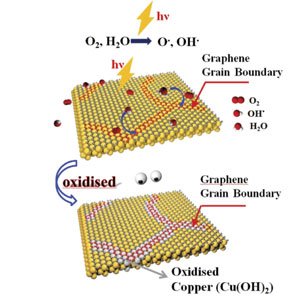Home > Press > A review article summarizes the state-of-the-art knowledge about graphene grain boundaries
 |
Abstract:
The graphene produced by chemical vapor deposition is typically polycrystalline. Authors from the ICN2 Theoretical and Computational Nanoscience Group, led by ICREA Research professor Stephan Roche, together with authors from Sungkyunkwan University, analyse in Advanced Materials the challenges and opportunities of these structures.
A review article summarizes the state-of-the-art knowledge about graphene grain boundaries
Barcelona, Spain | Posted on July 11th, 2014Graphene has attracted significant interest both for exploring fundamental science and for a wide range of technological applications. Chemical vapor deposition (CVD) is currently the only working approach to grow graphene at big scale, which is required for industrial applications. Unfortunately, the produced graphene is typically polycrystalline, consisting of a patchwork of grains with various orientations and sizes, joined by grain boundaries of irregular shapes.
Researchers from the Institut Catalŕ de Nanocičncia i Nanotecnologia (ICN2) Theoretical and Computational Nanoscience Group curated a review article in Advanced Materials to determine whether graphene grain boundaries are a blessing or a curse. ICREA Research Professor Stephan Roche, Group Leader at ICN2, together with Dr Aron Cummings, Jose Eduardo Barrios Vargas and Van Tuan Dinh, from the same Group, share the authorship of the review with researchers from Sungkyunkwan University. The review article not only provides guidelines for the improvement of graphene devices, but also opens a new research area of engineering graphene grain boundaries for highly sensitive electro-biochemical devices.
The review analyses the challenges and opportunities of charge transport in polycrystalline graphene, which means summarizing the state-of-the-art knowledge about graphene grain boundaries (GGBs). The review is divided in the following sections: Structure and Morphology of GGBs; Methods of Observing GGBs; Measurement of Electrical Transport across GGBs; Manipulation of GGBs with Functional Groups.
The work describes how TEM and STM, combined with theory and simulation, can provide information for the observation and characterization of GGBs at the atomic scale. These boundaries have interesting properties, such as the fact that they can be a good template for the synthesis of 1D materials, might be useful to design sensors for detecting gases and molecules or allow selective diffusion of limited gases and molecules. Controlling the atomic structure of GGBs by CVD is a big challenge from a scientific point of view, but would be a huge step forward in the realization of next-generation technologies based on this material.
####
For more information, please click here
Contacts:
Ŕlex Argemí, ICN2 Marketing and Communication Manager
Phone: 937372607
Fax: 937372607
Copyright © ICN2
If you have a comment, please Contact us.Issuers of news releases, not 7th Wave, Inc. or Nanotechnology Now, are solely responsible for the accuracy of the content.
| Related Links |
| Related News Press |
News and information
![]() Simulating magnetization in a Heisenberg quantum spin chain April 5th, 2024
Simulating magnetization in a Heisenberg quantum spin chain April 5th, 2024
![]() NRL charters Navy’s quantum inertial navigation path to reduce drift April 5th, 2024
NRL charters Navy’s quantum inertial navigation path to reduce drift April 5th, 2024
![]() Discovery points path to flash-like memory for storing qubits: Rice find could hasten development of nonvolatile quantum memory April 5th, 2024
Discovery points path to flash-like memory for storing qubits: Rice find could hasten development of nonvolatile quantum memory April 5th, 2024
Graphene/ Graphite
![]() NRL discovers two-dimensional waveguides February 16th, 2024
NRL discovers two-dimensional waveguides February 16th, 2024
Discoveries
![]() Chemical reactions can scramble quantum information as well as black holes April 5th, 2024
Chemical reactions can scramble quantum information as well as black holes April 5th, 2024
![]() New micromaterial releases nanoparticles that selectively destroy cancer cells April 5th, 2024
New micromaterial releases nanoparticles that selectively destroy cancer cells April 5th, 2024
![]() Utilizing palladium for addressing contact issues of buried oxide thin film transistors April 5th, 2024
Utilizing palladium for addressing contact issues of buried oxide thin film transistors April 5th, 2024
Materials/Metamaterials/Magnetoresistance
![]() Nanoscale CL thermometry with lanthanide-doped heavy-metal oxide in TEM March 8th, 2024
Nanoscale CL thermometry with lanthanide-doped heavy-metal oxide in TEM March 8th, 2024
![]() Focused ion beam technology: A single tool for a wide range of applications January 12th, 2024
Focused ion beam technology: A single tool for a wide range of applications January 12th, 2024
Announcements
![]() NRL charters Navy’s quantum inertial navigation path to reduce drift April 5th, 2024
NRL charters Navy’s quantum inertial navigation path to reduce drift April 5th, 2024
![]() Discovery points path to flash-like memory for storing qubits: Rice find could hasten development of nonvolatile quantum memory April 5th, 2024
Discovery points path to flash-like memory for storing qubits: Rice find could hasten development of nonvolatile quantum memory April 5th, 2024
Interviews/Book Reviews/Essays/Reports/Podcasts/Journals/White papers/Posters
![]() Simulating magnetization in a Heisenberg quantum spin chain April 5th, 2024
Simulating magnetization in a Heisenberg quantum spin chain April 5th, 2024
![]() Discovery points path to flash-like memory for storing qubits: Rice find could hasten development of nonvolatile quantum memory April 5th, 2024
Discovery points path to flash-like memory for storing qubits: Rice find could hasten development of nonvolatile quantum memory April 5th, 2024
|
|
||
|
|
||
| The latest news from around the world, FREE | ||
|
|
||
|
|
||
| Premium Products | ||
|
|
||
|
Only the news you want to read!
Learn More |
||
|
|
||
|
Full-service, expert consulting
Learn More |
||
|
|
||








